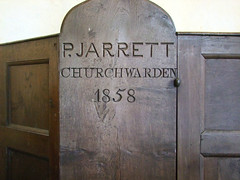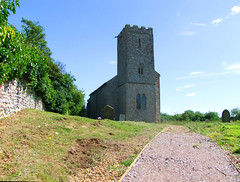| |
|
All
Saints, Bircham Newton I don't know this part of Norfolk
at all well. I climbed the road up from Great Bircham
without really knowing what to expect. St Mary at Great
Bircham was a big church, but as I came into Bircham
Newton after little more than a fleeting glimpse of
fields, I saw that All Saints was something quite
different, a small church with much to show of its Norman
origins. A hilltop church, but the most striking thing
was that the long graveyard beyond the church was almost
completely submerged in a sea of waist-high yellow
flowers. I get so used to seeing churchyards trimmed
within an inch of their lives by August that I did wonder
for a second if All Saints was still in use, but I need
not have worried.
I stepped
into an interior which is nothing short of an utter
delight. The rugged font, melting like a big fat cheese,
sits on the stone flagged floor, and to the east spreads
a delicious range of mid-19th Century box pews. This is
the result of a gentle restoration of 1858 under the
auspices of one P Jarrett, churchwarden, who had his name
proudly inscribed on the north side westernmost pew. Mr
Jarrett was probably the kind of churchwarden who didn't
know much but knew what he liked, and thank goodness he
stuck to his guns here. He was probably getting on in
years, because the restoration harks back to the English
Church of half a century earlier, and the two decker
pulpit and the Hanoverian arms above the chancel arch are
a truer mark of the church's character. Like the font,
the chancel arch looks as if it might be melting. There
is no coloured glass, and light filled the church on this
summer afternoon, slanting in from the south and warming
the woodwork, casting images of windows across the stone
floor.
| Stepping
up into the chancel, which is tiny and all of a
piece, there is a simple memorial on the south
wall to a two year old boy, John James Stephens
Ward, son of the Rector. The thing that makes it
noteworthy is that he was Nelson's grandson. His
mother, Horatia Nelson, mentioned on the
memorial, was the illegitimate daughter of Nelson
and Lady Emma Hamilton. Horatia married Philip
Ward, who at the time had been the curate in her
father's parish at Burnham Thorpe. Winifred
Gerin, in her biography Horatia (1970),
describes the marriage as the one certain
good that befell Horatia. On the
other side of the chancel is a very good effigy
of a 14th Century priest, sleeping under a
canopy. Unfortunately, I was so taken by how
lovely the church was that I didn't notice that
my shot of it was out of focus. Well, if that
gives me the excuse to go back one day, it is no
bad thing. Meanwhile, a ledger stone to the west
tells us that Ambrose Allen, who died in 1728, by
his carefull industry raised a fair fortune to
his family. How lucky he is to be resting
now in this special place.
|
|
 |
|
|
|

